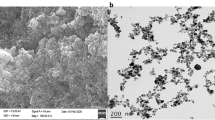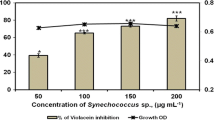Abstract
We report the synthesis and antimicrobial properties of a partially reduced dihydronathphthoquinone analogue of 2-methoxy, 5-acetoxy calamenene, extracted from Subergorgia reticulata. The growth of a pathogenic Vibrio harveyi strain was effectively controlled by the calamenene derivative 1 (Cala1) and its synthetic analog 2 (Cala2). Complete mortality of V. harveyi was observed with 2.5 and 0.5 µg mL−1 concentrations of Cala1 and Cala2, respectively. The metabolic assays demonstrated that Cala1 is a bacteriostatic agent while Cala2 showed bactericidal properties. It was confirmed that translocation of Cala2 into the cytoplasm does not induce any change to the integrity of the bacterial cell wall. The Cala2 induced damage to the genetic material of 70% of cells while genetic material of 91% of cells treated with Cala1 remained intact. The Cala2 is, therefore, proposed as a potential bactericidal compound against the aquaculture pathogen V. harveyi. The fact that the Cala2 exhibited minimal cytotoxicity to Artemia nauplii indicates its potential use as an antimicrobial agent for aquaculture operations.






Similar content being viewed by others
References
Ali MFZ, Yasin IA, Ohta T, Hashizume A, Ido A, Takahashi T, Miura C, Miura T (2018) The silkrose of Bombyx mori effectively prevents vibriosis in penaeid prawns via the activation of innate immunity. Sci Rep 8(1):8836. https://doi.org/10.1038/s41598-018-27241-3
Anas A, Jiya J, Rameez MJ, Anand PB, Anantharaman MR, Nair S (2013) Sequential interactions of silver–silica nanocomposite (Ag–SiO2NC) with cell wall, metabolism and genetic stability of Pseudomonas aeruginosa, a multiple antibiotic-resistant bacterium. Lett Appl Microbiol 56(1):57–62. https://doi.org/10.1111/lam.12015
Asok A, Arshad E, Jasmin C, Somnath Pai S, Bright Singh I, Mohandas A, Anas A (2012) Reducing Vibrio load in Artemia nauplii using antimicrobial photodynamic therapy: a promising strategy to reduce antibiotic application in shrimp larviculture. Microb Biotechnol 5(1):59–68
Asplund ME, Rehnstam-Holm A-S, Atnur V, Raghunath P, Saeavanan V, Harnstrom K, Collin B, Karunasagar I, Godhe A (2011) Water column dynamics of Vibrio in relation to phytoplankton community composition and environmental conditions in a tropical coastal area. Environ Microbiol 13(10):2738–2751
Azevedo MMB, Chavesm FCM, Almeida CA, Bizzo HR, Duarte RS, Campos-Takaki GM, Alviano CS, Alviano DS (2013) Antioxidant and antimicrobial activities of 7-hydroxy-calamenene-rich essential oils from Croton cajucara Benth. Molecules 18:1128–1137
Benoit-Vical F, Valentin A, Mallíe M, Bastide J-M, Bessière J-M (1999) In vitro antimalarial activity and cytotoxicity of Cochlospermum tinctorium and C. planchonii leaf extracts and essential oils. Planta Med 65(04):378–381. https://doi.org/10.1055/s-2006-960794
Brogden KA (2005) Antimicrobial peptides: pore formers or metabolic inhibitors in bacteria? Nat Rev Microbiol 3(3):238–250
Burres NS, Barber DA, Gunasekera SP, Shen LL, Clement JJ (1991) Antitumor activity and biochemical effects of topsentin. Biochem Pharmacol 42(4):745–751
Correa H, Aristizabal F, Duque C, Kerr R (2011) Cytotoxic and antimicrobial activity of pseudopterosins and seco-pseudopterosins isolated from the octocoral Pseudopterogorgia elisabethae of San Andres and Providencia Islands (Southwest Caribbean Sea). Mar Drugs 9(3):334–344
Essack M, Bajic VB, Archer JAC (2011) Recently confirmed apoptosis-inducing lead compounds isolated from marine sponge of potential relevance in cancer treatment. Mar Drugs 9(9):1580–1606
Fenical W, Pawlik J (1991) Defensive properties of secondary metabolites from the Caribbean gorgonian coral Erythropodium caribaeorum. Mar Ecol Prog Ser 75(1):1–8
Gordaliza M (2012) Synthetic strategies to terpene quinines/hydroquinones. Mar Drugs 10(2):358–402
Griffitt KJ III, Johnson CN, Jay Grimes D (2011) Enumeration of Vibrio parahaemolyticus in the viable but nonculturable state using direct plate counts and recognition of individual gene fluorescence in situ hybridization. J Microbiol Methods 85:114–118
Haefner B (2003) Drugs from the deep: marine natural products as drug candidates. Drug Discov Today 8(12):536–544
Harvell C, Fenical W, Greene C (1988) Chemical and structural defenses of Caribbean gorgonians (Pseudopterogorgia spp.). 1. Development of an in situ feeding assay. Mar Ecol Prog Ser 49(3):287–294
Heidarieh M, Mirvaghefi AR, Akbari M, Farahmand H, Sheikhzadeh N, Shahbazfar AA, Behgar M (2012) Effect of dietary Ergosan on growth performance, digestive enzymes, intestinal histology, hematological parameters and body composition of rainbow trout (Oncorhynchus mykiss). Fish Physiol Biochem 38:1169–1174
Hunt LR, Smith SM, Downum KR, Mydlarz LD (2012) Microbial regulation in gorgonian corals. Marine Drugs 10(6):1225–1243
Jones RM, Bulaj G (2000) Conotoxins-new vistas for peptide therapeutics. Curr Pharm Des 6(12):1249–1285
Jose J, Anas A, Jose B, Puthirath AB, Athiyanathil S, Jasmin C, Anantharaman MR, Nair S, Subrahmanyam C, Biju V (2019) Extinction of antimicrobial resistant pathogens using silver embedded silica nanoparticles and an efflux pump blocker. ACS Appl Biomater 2(11):4681–4686. https://doi.org/10.1021/acsabm.9b00614
Kanjana K, Radtanatip T, Asuvapongpatana S, Withyachumnarnkul B, Wongprasert K (2011) Solvent extracts of the red seaweed Gracilaria fisheri prevent Vibrio harveyi infections in the black tiger shrimp Penaeus monodon. Fish Shellfish Immunol 30(1):389–396. https://doi.org/10.1016/j.fsi.2010.11.016
Kelman D, Kushmaro A, Loya Y, Kashman Y, Benayahu Y (1998) Antimicrobial activity of a Red Sea soft coral, Parerythropodium fulvum fulvum: reproductive and developmental considerations. Mar Ecol Prog Ser 169:87–95
Kelman D, Benayahu Y, Kashman Y (2000) Chemical defence of the soft coral Parerythropodium fulvum fulvum (Forskal) in the Red Sea. J Exp Mar Biol Ecol 243:309–312
Kim MK, Park J, Chong Y (2012) Aromatic hydroxyl group plays a critical role in antibacterial activity of the curcumin analogues. Nat Prod Commun 7(1):57
Kohanski MA, Dwyer DJ, Collins JJ (2010) How antibiotics kill bacteria: from targets to networks. Nat Rev Microbiol 8(6):423–435. https://doi.org/10.1038/nrmicro2333
Langeveld WT, Veldhuizen EJA, Burt SA (2014) Synergy between essential oil components and antibiotics: a review. Crit Rev Microbiol 40(1):76–94. https://doi.org/10.3109/1040841X.2013.763219
Limna Mol VP, Raveendran TV, Naik BG, Kunnath RJ, Parameswaran PS (2011) Calamenenes—aromatic monocyclic sesquiterpenes from the Indian gorgonian Subergorgia reticulata. Nat Prod Res 25(2):169–174
Lok CN, Ho CM, Chen R, He QY, Yu WY, Sun H, Tam PKH, Chiu JF, Che CM (2006) Proteomic analysis of the mode of antibacterial action of silver nanoparticles. J Proteome Res 5(4):916–924
Marques A, Dhont J, Sorgeloos P, Bossier P (2004) Evaluation of different yeast cell wall mutants and microalgae strains as feed for gnotobiotically grown brine shrimp Artemia franciscana. J Exp Mar Biol Ecol 312(1):115–136. https://doi.org/10.1016/j.jembe.2004.06.008
Oliver JD (2005) The viable but nonculturable state in bacteria. J Microbiol 43(S):93–100
Overton SV, Bland CE (1981) Infection of Artemia salina by Haliphthoros milfordensis: a scanning and transmission electron microscope study. J Invertebr Pathol 37(3):249–257. https://doi.org/10.1016/0022-2011(81)90083-5
Racault M-F, Abdulaziz A, George G, Menon N, Punathil M, McConville K, Loveday B, Platt T, Sathyendranath S, Vijayan V (2019) Environmental reservoirs of Vibrio cholerae: challenges and opportunities for ocean-color remote sensing. Remote Sens 11(23):2763
Raveendran TV, Limna Mol VP, Parameswaran PS (2011) Natural product antifoulants from the Octocorals of Indian waters. Int Biodeterior Biodegrad 65(1):265–268
Reddy DRS, Audipudi AV, Reddy GD (2011) Antioxidant, antiinflammatory and antifungal activity of marine sponge subergargoria suberosa-derived natural products. Int J PharmTech Res 3(1):342–348
Sahul Hameed A, Balasubramanian G (2000) Antibiotic resistance in bacteria isolated from Artemia nauplii and efficacy of formaldehyde to control bacterial load. Aquaculture 183(3):195–205
Santhakumari S, Kannappan A, Pandian SK, Thajuddin N, Rajendran RB, Ravi AV (2016) Inhibitory effect of marine cyanobacterial extract on biofilm formation and virulence factor production of bacterial pathogens causing vibriosis in aquaculture. J Appl Phycol 28(1):313–324
Schug T, Abagyan R, Blumberg B, Collins T, Crews D, DeFur P, Dickerson S, Edwards T, Gore A, Guillette L (2013) Designing endocrine disruption out of the next generation of chemicals. Green Chem 15(1):181–198
Singh NP, McCoy MT, Tice RR, Schneider EL (1988) A simple technique for quantitation of low levels of DNA damage in individual cells. Exp Cell Res 175(1):184–191
Slattery M, McClintock JB, Heine JN (1995) Chemical defenses in Antarctic soft corals: evidence for antifouling compounds. J Exp Mar Biol Ecol 190(1):61–77
Thakur NL, Thakur AN, Muller WEG (2005) Marine natural products in drug discovery. Nat Prod Radiance 4(6):471–477
Vandenberghe J, Li Y, Verdonck L, Li J, Sorgeloos P, Xu H, Swings J (1998) Vibrios associated with Penaeus chinensis (Crustacea: Decapoda) larvae in Chinese shrimp hatcheries. Aquaculture 169(1):121–132
Acknowledgements
The authors thank the Directors of CSIR—National Institute of Oceanography, Goa and the Scientist-in-Charge, NIO Regional Centre, Kochi, for extending all required support in carrying out this work.
Author information
Authors and Affiliations
Corresponding author
Ethics declarations
Conflict of interest
The authors declare no conflict of interest.
Electronic supplementary material
Below is the link to the electronic supplementary material.
Rights and permissions
About this article
Cite this article
Limna Mol, V.P., Abdulaziz, A., Sneha, K.G. et al. Inhibition of pathogenic Vibrio harveyi using calamenene, derived from the Indian gorgonian Subergorgia reticulata, and its synthetic analog. 3 Biotech 10, 248 (2020). https://doi.org/10.1007/s13205-020-02241-1
Received:
Accepted:
Published:
DOI: https://doi.org/10.1007/s13205-020-02241-1




